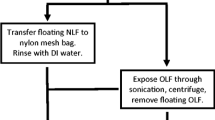Abstract
Sodium polytungstate (SPT) is currently the material of choice for soil density fractionation (DF). We recently detected high levels of N in several types of commercially available SPT (0.74–1.4 mg g−1), raising a concern that undesirable chemical effects on soils may occur during the DF procedure. To address this concern, we conducted two experiments to examine effects of SPT on C and N in the resulting soil fractions. First we suspended A-horizon material from three soil types of greatly differing mineralogy for 24 h in solutions containing three types of commercially obtained SPT and commercial SPT that had been passed through cation exchange resin columns. We compared %C, %N, 15N and 13C values in treated and untreated soils. We also spiked SPT with tracer-level 15NH4 + to measure potential NH4 + absorption by the soil fractions. Results suggest that the N-rich commercially available SPT can have a considerable effect on δ15N values, likely due to the presence of 15N-enriched NH4 + in the SPT. In one of our soils, 15N enrichment of 3‰ was observed associated with overnight soaking in N-rich SPT (0.74 mg g−1). By contrast, when using SPT with low levels of N (0.05 mg g−1), no significant changes in 15N were observed. The remaining soil (after suspension and rinsing) was similar in %C, %N, 15N and 13C to the untreated bulk soil, suggesting that suspension of soil in SPT with low N levels purchased from the manufacturer or else through treatment with cation exchange resins does not greatly alter these variables. Low-N SPT is available commercially although it must be specifically requested from the manufacturer and is currently more expensive to purchase. Our results confirm that SPT tested and known to be low in C and N (<0.06 mg g−1) does not adversely contaminate soils during the soil density fractionation procedure. If using newly purchased or recycled SPT with higher N or C levels than this, we recommend thorough testing for possible contamination effects prior to use. However we caution against using SPT that contains N or C levels >0.5 mg g−1.



Similar content being viewed by others
References
Baisden WT, Amundson R, Cook AC, Brenner DL (2002) Turnover and storage of C and N in five density fractions from California annual grassland surface soils. Glob Biogeochem Cycles 16:1117
Basile-Doelsch I, Amundson R, Stone WEE, Borschneck D, Bottero JY, Moustier S, Masin F, Colin F (2007) Mineral control of carbon pools in a volcanic soil horizon. Geoderma 137:477–489
Crow SE, Swanston C, Lajtha K, Brooks JR, Keirstead H (2007) Density fractionation of forest soils: methodological questions and interpretation of incubation results and turnover time in an ecosystem context. Biogeochemistry 85:69–90
Evans Jr, Zelazny LW, Zipper CE (1988) Solution parameters influencing dissolved organic carbon levels in three forest soils. Soil Sci Soc Am J 52:1789–1792
Kaiser K, Guggenberger G (2007) Distribution of hydrous aluminium and iron over density fractions depends on organic matter load and ultrasonic dispersion. Geoderma 140:140–146
Kramer MG, Sollins P, Sletten RS, Swart P (2003) N isotope fractionation and measures of organic matter alteration during decomposition. Ecology 84:2021–2025
Six J, Schultz PA, Jastrow JD, Merck R (1999) Recycling of sodium polytungstate used in soil organic matter studies. Soil Biol Biochem 31:1193–1196
Sollins P, Swanston C, Kleber M, Filley T, Kramer MG, Crow S, Caldwell B, Lajtha K, Bowden R (2006) Organic C and N stabilization in a forest soil: evidence from sequential density fractionation. Soil Biol Biochem 38:3313–3324
Acknowledgments
We thank Jonathan Giska and Russell Johnson for help with running the experiments. Funding for this work was provided by grants from the USDA CSREES NRI program (2007-03184 to Marc Kramer, 2002-35107-12249 to Kate Lajtha and 2005-35107-16336 to Phillip Sollins).
Author information
Authors and Affiliations
Corresponding author
Rights and permissions
About this article
Cite this article
Kramer, M.G., Lajtha, K., Thomas, G. et al. Contamination effects on soil density fractions from high N or C content sodium polytungstate. Biogeochemistry 92, 177–181 (2009). https://doi.org/10.1007/s10533-008-9268-6
Received:
Accepted:
Published:
Issue Date:
DOI: https://doi.org/10.1007/s10533-008-9268-6




